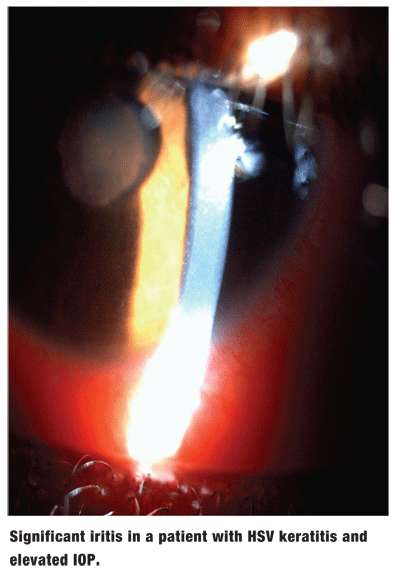 Upon hearing the word glaucoma, you immediately think of the back of the eye. You are well aware that an increased intraocular pressure (IOP) may cause irreparable damage to the optic nerve and nerve fiber layer. However, did you know that a better understanding of certain viral diseases might help you prevent glaucoma development in your patients? Research suggests some viral conditions detected in clinical practice serve as catalysts for the development of glaucoma. One study suggested that more than 50% of patients who have herpes zoster ophthalmicus (HZO) develop glaucoma within 10 years of the initial diagnosis.1 This months column will identify some of the viral conditions you should regularly monitor patients for to help protect them from glaucoma.
Upon hearing the word glaucoma, you immediately think of the back of the eye. You are well aware that an increased intraocular pressure (IOP) may cause irreparable damage to the optic nerve and nerve fiber layer. However, did you know that a better understanding of certain viral diseases might help you prevent glaucoma development in your patients? Research suggests some viral conditions detected in clinical practice serve as catalysts for the development of glaucoma. One study suggested that more than 50% of patients who have herpes zoster ophthalmicus (HZO) develop glaucoma within 10 years of the initial diagnosis.1 This months column will identify some of the viral conditions you should regularly monitor patients for to help protect them from glaucoma.
Primary Viral Conditions
The two principal viral conditions associated with glaucoma are HZO and herpes simplex virus (HSV). One evaluation compared clinical characteristics of patients diagnosed with uveitis secondary to HSV or varicella zoster virus (VZV), the latent form of HZO. Patients from both the HSV and the VZV populations were of comparable age and gender at the time of original diagnosis. Symptoms of uveitis were found to be both remittent and recurrent in patients with HSV, and entirely chronic in patients with VZV. Secondary glaucoma was the most prevalent complication found in both groups. Specifically, 54% of patients with HSV and 38% of patients with VZV developed secondary glaucoma.2
Patients with HZO are likely to suffer from ocular disorders such as pseudodendrites, neurotropic keratitis, iritis, conjunctivitis and cranial nerve palsies. Researchers have also discovered that an increased IOP from HZO-iritis might promote the onset of glaucoma. A study by ophthalmologists J.H. Thean, A.J. Hall and R.J. Stawell found that more than 56% of the patients with HZO-iritis developed glaucoma within a 10-year period following initial diagnosis.1
 A different study by S.P Harding suggested that uveitis is the fundamental cause of glaucoma in patients with HZO.3 In this instance, uveitis likely produced an inflammation of the trabecular meshwork, which subsequently caused an increased IOP. Thean, Hall, and Stawell supported Hardings findings, as they concluded the majority of their patients with HZO-uveitis had corresponding elevated IOP.1
A different study by S.P Harding suggested that uveitis is the fundamental cause of glaucoma in patients with HZO.3 In this instance, uveitis likely produced an inflammation of the trabecular meshwork, which subsequently caused an increased IOP. Thean, Hall, and Stawell supported Hardings findings, as they concluded the majority of their patients with HZO-uveitis had corresponding elevated IOP.1
As previously noted, many patients diagnosed with HSV-uveitis also have glaucoma. In one study, primary cultures of human trabecular meshwork cells demonstrated the ability of HSV to enter the trabeculum and establish a productive infection.4 Pathology reports suggest that damage to the trabeculum resulting from HSV infection might be a leading cause in the development of glaucoma.4
Other Viral Etiologies
New research advocates that some secondary glaucomas, including the more uncommon ICE syndromes, may have viral etiologies. Since patients with ICE syndromes often test positive for either HSV or Epstein-Barr virus, many physicians believe these viruses are linked to secondary glaucoma.5 Additionally, other research has suggested a potential correlation between the Epstein-Barr virus and some secondary glaucomas.
A study at the
Ophthalmologists from the
Why is understanding the role of viral ocular conditions so important to glaucoma management? The answer: to prevent blindness. A research study conducted from 1987 to 1999 at Harvard Medical School found that more than 20% of the subjects with either HZO or HSV became legally blind over the 12-year observation period.2-5,7,8 Physicians must be aware of the dangers associated with anterior uveitis, and should prescribe prompt and aggressive treatment for their patients suffering from any viral ocular conditions.
Although some of these conditions, such as the ICE syndromes, are relatively rare, others, such as HZO and HSV, are very common. Nearly every optometrist will manage several patients with either viral condition during his or her career. Patients with either HZO or HSV must be monitored routinely for glaucoma development. Simply recommending treatment for these viral conditions may not be sufficient in preventing glaucoma.
1. Thean JH, Hall AJ, Stawell RJ. Uveitis in Herpes Zoster Ophthalmicus. Clin Experiment Ophthalmology. 2001 Dec;29(6):406-10.
2. Miserocchi E, Waheed NK, Dios E, et al. Visual outcome in herpes simplex virus and varicella zoster virus uveitis: a clinical evaluation and comparison. Ophthalmology. 2002 Aug;109(8):1532-7.
3. Harding SP. Management of ophthalmic Zzoster. J Med Virology. 1993; Suppl 1:97-101.
4.Tiwari V, Clement C, Scanlan PM et al. A role for herpes virus entry mediator as the receptor for herpes simplex virus-1 entry into primary human trabecular meshwork cells. J Virol. 2005 Oct;79(20):13173-9.
5. Morris RW,
6. Alvarado JA, Underwood JL, Green WR, et al. Detection of herpes simplex viral DNA in the iridocorneal endothelial syndrome. Arch Ophthalmal. 1994 Dec;112(12):1601-9.
7. Detorakis ET, Kozobolis VP., Pallikaris I,G et al. Detection of HSV in pseudoexfoliation syndrome and exfoliation glaucoma. Acta Ophthalmology Scand. 2002 Dec;80(6):612-6.
8.











